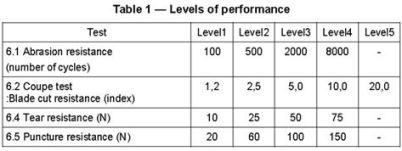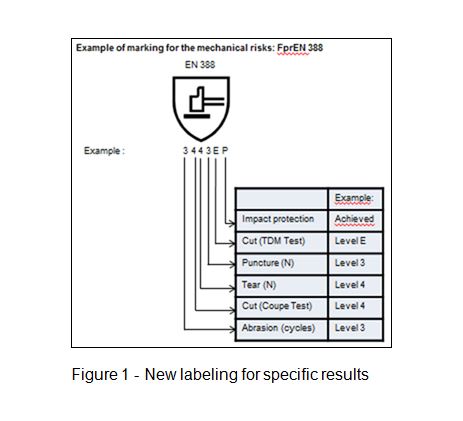
Page 2 of 4
New Global Standards for Protective Gloves Are Coming
Hand injuries are among the most common of work-related injuries. Of these, nearly one-third involve cuts or lacerations. Such injuries are also becoming more costly: According to the National Safety Council, a single hand laceration can cost over $12,000 in direct and related costs; if a tendon is severed, the cost can approach $70,000.1
When the expense of a single injury can far exceed the full cost of an entire hand protection program, selecting the most effective cut-resistant apparel and PPE becomes an especially critical decision.
Of course, cut protection is more than just cut resistance. It's a combination of glove attributes that also include tear strength, abrasion resistance, grip, and dexterity—as well as workplace factors such as machine guarding, workplace set-up, working conditions, and worker training. But wearing the right glove at the right time is vital. The new glove standards will help you choose the right protection with greater precision and accuracy than before.
Current Standards
To help guide PPE purchasers, both the American National Standards Institute (ANSI) and the European Union (EU) have developed standards for cut-resistant materials. The U.S. standard is ANSI/ISEA 105 ("American National Standard for Hand Protection"), which rates gloves and other cut protective clothing on a consistent numeric rating scheme for mechanical, thermal, chemical, dexterity, and other performance criteria.
Although the use of the ANSI/ISEA selection criteria is not mandatory in the United States, most safety managers choose to follow it in selecting the right protection for their employees.
The EU standard EN 388 ("Protective Gloves Against Mechanical Risks") rates gloves and other cut protective clothing for puncture, tear, blade cut, and abrasion resistance. Beyond the European Union, this standard is also recognized globally.
While these standards provide a useful guide, they are not interchangeable. Each uses a totally different test method and numeric performance rating. As a result, there is a growing need for a more consistent testing method and ratings that take into account recent advances in cut-resistant yarns and technologies.
Proposed changes have been submitted for both the ANSI/ISEA 105 Hand Protection Selection Criteria and the EN 388 European regulatory standard for protective gloves. Everyone involved in the design, development, and specification of cut-resistant apparel and PPE needs to understand the impact of these changes on their selection and purchasing decisions.
Why Change Is Needed
ANSI/ISEA 105
In recent years, as new yarns and new technologies have been developed, performance of cut-resistant gloves has improved tremendously. The market has also evolved: There are more options now in the range from 1,500 to 3,500 grams and above the 3,500 grams level.
The proposed change to ANSI/ISEA levels will allow the PPE user to make a more informed decision about the level of protection needed. The increased granularity that would occur within the current level 4 range (1,500-3,499 grams) would allow the glove manufacturer to identify gloves with a higher level of cut protection from other gloves in the same range—a distinction not available under current standards.
Also, under current standards, it's possible to confuse all gloves within the ANSI/ISEA cut level 4 range as offering the same level of performance. The proposed scale will allow users to see the differences between gloves in this range.
EN 388
The EN 388 standard now in use was in need of revision due to issues of reproducibility specific to the cut and abrasion parts of the standard. The proposed changes focus on these aspects. Similar to the ANSI/ISEA goal of a globally recognized test method, the EN 388 has adopted the ISO 13997 TDM test as a more reliable test method. Although the Coupe test has been retained for now (in order to ensure continuity of information in the immediate future), it will probably be removed at the beginning of the next five-year revision cycle.
Also, the current standard does not include a requirement or test for impact protection, which has become an increasingly important performance feature. This has been added to the new standard.
What You Need to Know About the New Standards
ANSI/ISEA 105
The proposed ANSI/ISEA 105-16 version calls for an increase in cut performance ratings from five to nine levels. It will reference only the TDM Test Method, based on the ASTM F2992-15 standard, while discarding the CPPT method. The TDM test method will make use of a new ASTM standard with updates to the methodology.
Although the use of the ANSI/ISEA selection criteria is not mandatory in the United States, most safety managers choose to provide the right protection for their employees. Because glove manufacturers are not required to change from the current ANSI/ISEA 105-11 standard to the proposed ANSI/ISEA 105-16 standard, it is highly likely that there will be a mix of identifications of cut resistance in the marketplace. Additionally, until a timeline for completion of changes to the proposed standard has been set, we can expect continued variability in PPE identification throughout the marketplace.
ISEA will receive public comments on the proposed revision until Nov. 23, 2015. A link to its website is: https://safetyequipment.org/isea-announces-public-review-for-high-visibility-apparel-hand-protection-selection-standards/.
EN 388
Proposed changes would affect the EN 388 standard in a number of significant areas. These include acceptance of the ISO 13997 (TDM) cut test method; amending the Coupe test to take into account dulling of the blade; change of the abrasive paper; improved procedures for a number of other tests; added test report requirements; and the addition of an impact protection threshold.
Use of the ISO 13997 (TDM) test as an equivalent method is a major step. Under this change, the six lower cut levels will be aligned to the ANSI/ISEA 105 method (although the results will still be reported in Newtons, not grams). Levels rated though the TDM method will be lettered (A through F) to avoid confusion with the Coupe method, which will still use numerical labels (1 through 5).
The Coupe test method has been changed to make it more reproducible and to take into account the dulling of the blade that occurs during the test. The cutting speed of the blade has been adjusted for better precision with the rotary blade, and there is now more detailed specification of the blade in regards to hardness and the recommendation of supplier. Test specimen requirements now call for two specimens from two separate gloves and a test of the complete specimen with all layers together. In the case of irregular palm design, the test specimen should still be taken from the palm area but from where the least amount of protection is needed.
Calibration of the TDM machine is improved. For control specimens and cotton canvas specifications, a new recommended supplier is specified. Control over sharpness of the blade has been enhanced, and a specific equation has been created to determine the maximum number of cycles at which test should be stopped to measure dulling. If dulling is detected, the TDM test becomes the new reference test method. Results obtained from the Coupe method may optionally be reported, but an addition to the "Instructions for Use" or the manufacturer's instructions must state there was dulling of the blade, the Coupe test results are for reference only, and the TDM test results are the final report of the material's performance.
The abrasion test segment, which uses the Martindale abrasion method, has changed the type of abrasive paper to be used (the previous recommended supplier could not guarantee the reproducibility of the paper, grit size, and glue). The effect of this change is that new abrasion resistance results are lower for an equivalent textile, potentially by up to one level. The tables below show how the new levels will be reported. Figure 1 also shows what the changes may look like for a typical test.



Because any changes to EN 388 will be compulsory, introduction of the new EN 388 standard will be different than that of ANSI/ISEA. However, many of the gloves and sleeves used in the United States very often contain both the ANSI/ISEA cut level as well as the EN 388 cut level, and since performance identification is not required in North America, gloves are sometimes marked with only the cut level obtained as a result of the EN388 test. Although there is an addition to the EN rating system that attempts to harmonize glove identification through the use of the ISO 13997 method, there will continue to be different identification markings and performance rankings on gloves tested using the EN 388 method compared with those tested by the ANSI/ISEA method. The use of new markings under the ANSI/ISEA method, the addition of new markings for the CE ratings under the EN 388 test method, and the continued use of different types of test equipment between the two standards will continue to promote confusion in the marketplace around proper PPE choices.
When Will These Changes Take Effect?
In North America, the proposed standard is currently out for review to ANSI/ISEA committee members and is still subject to change. The information in the sections above represents our best knowledge based on our involvement with the ANSI/ISEA committee. The final changes are pending acceptance with the December committee meeting. If accepted, they would become official with the 2016 standard revision.
In Europe, the proposed EN388 changes have already gone through a series of votes, and the committee has approved the draft to allow a final ballot to take place sometime during the fourth quarter of 2015. Given a positive vote, the new standard would become effective either in late 2015 or early 2016. It is important to note that, although the EN 388 standard has been adopted outside of the EU, the changes will only apply to the EU until the new standard has been adopted or transposed in other countries, such as China and Brazil.
References
1. http://www.ishn.com/articles/94029-drive-home-the-value-of-gloves--hand-injuries-send-a-million-workers-to-ers-each-year
This article originally appeared in the November 2015 issue of Occupational Health & Safety.